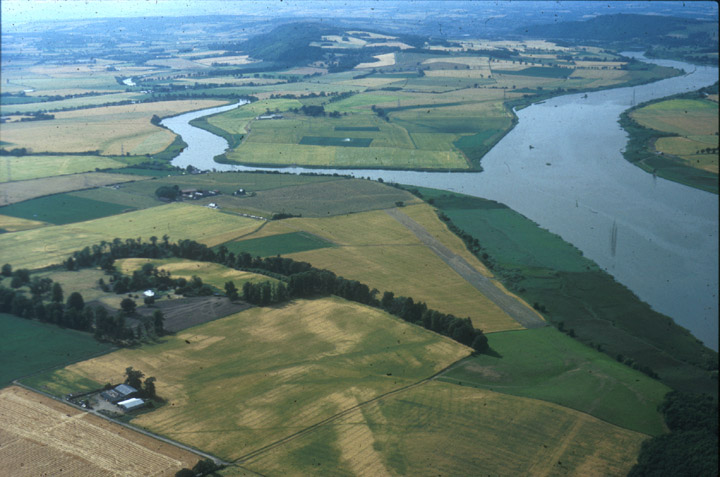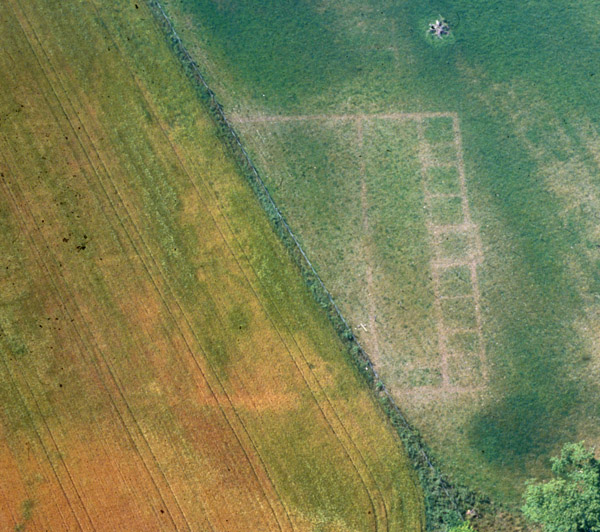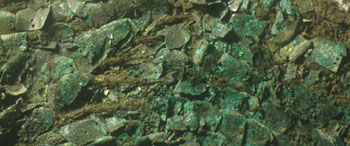Carpow lies on the south bank of the Tay Estuary, just east of its confluence
with the Earn. Roman remains were noted here in the eighteenth century,
but it was not until 1961-2 that a formal investigation of the site was
made. By then aerial photography had revealed a rampart and double ditch
enclosing some 12 ha. (30 acres), surrounded by annexes and other enclosures.
Excavation confirmed the presence of a major military
base dating to the early third century, almost certainly connected with
the campaigns of the emperor Severus
against the Caledonians and Maeatae between 208 and 211.

Junction of the rivers Tay (right) and
Earn (left), looking west. The fortress lies in the centre foreground,
where various crop-marks can be seen.
© Colin Martin
The fort’s main buildings were solidly constructed of stone, suggesting that permanent occupation had been intended. At the centre stood a massive headquarters building, or principia. On one side of it was a buttressed granary; on the other palatial quarters for the fort’s commander. Both the principia and the commander’s house had been roofed with tiles stamped with the mark of the Sixth Victrix Legion. To its honorific title ‘PF’, standing for ‘Pia Fidelis’ (dutiful and faithful) had been added the letter ‘B’ for ‘Britannica’ - achievers of victory in Britain. The same title had been adopted by Severus and his sons.

Aerial view of the principia
at Carpow, showing as parch-marks during a drought.
© Colin Martin
Fragments of sculptured panels and inscriptions were found in the vicinity
of two of the gates. One appears to refer to the emperor in the singular.
This suggests that the inscription is later than February 212. The explanation
is as follows. Up to his death in February 211 Severus was co-emperor
with his sons Caracalla and Geta. When Severus died at York the empire
passed jointly to them. A year later, however, Caracalla murdered his
brother to become sole emperor. The Carpow inscription seems to mention
only one emperor, in which case it must post-date Geta’s murder.
This casts doubt on contemporary accounts of the campaigns in Scotland,
which claim that immediately after Severus’s death Caracalla abandoned
the recently-conquered territories. That building work appears to have
been going on at Carpow a year or more later throws this claim into question.
Carpow was probably the forward link in a maritime supply chain which ran from South Shields on the Tyne via Cramond on the Forth. Severus’s strategy appears to have been to support his massive forces in the north entirely by sea, to avoid the need of setting up costly and vulnerable land-lines of communications, as Agricola and Lollius Urbicus had done before. This suggests that Severus’s intention was to punish the northern tribes, but not to occupy their territories permanently.
An enclosure surrounding the fort at Carpow may have been a defended beach-head
for the initial landings. It overlooks the estuary bank, along which shipping
could conveniently have berthed. These facilities would have allowed the
build-up of forces needed to launch a crossing of the Tay prior to campaigning
in the Caledonian territories beyond. A coin of Caracalla dated to 209
shows an army crossing a bridge of boats, and it has been suggested that
such a crossing may have been made at Carpow.
|
|
 |
Roof tile from Carpow, marked 'LEG.VI.VIC.BPF'
(Sixth Victrix Legion, victors in Britain, dutiful and
faithful). |
Detail from a
piece of scale armour, found at Carpow. © Colin Martin |
The ancient authors Herodian and Cassisus Dio were hostile to Severus and his sons, and belittle their achievements in Caledonia. However the fact that relative peace prevailed on the frontier for almost a century afterwards suggests that these campaigns had been effective.
